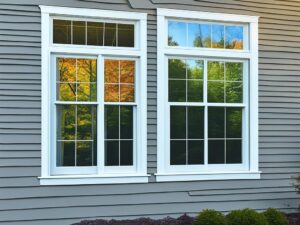Introduction
Rotted vertical wood siding can be a homeowner’s nightmare. It not only affects the aesthetic appeal of your home but also compromises its structural integrity. Fortunately, repairing rotted wood siding is a manageable task that you can tackle with the right knowledge and tools. In this comprehensive guide, we will walk you through the step-by-step process of repairing rotted vertical wood siding, ensuring your home stays beautiful and strong.
Understanding the Causes of Rotted Wood Siding
Before you embark on repairing your rotted wood siding, it’s crucial to understand what led to the damage in the first place. Common causes include prolonged exposure to moisture, termites, or other pests, inadequate maintenance, and poor ventilation. Identifying the root cause will help you prevent future damage.
Assessing the Damage
Begin by thoroughly inspecting the affected area. Determine the extent of the rot and whether it has spread to the underlying structure. This assessment will guide you in deciding whether a partial or full replacement is necessary.
Gathering the Necessary Tools and Materials
To effectively repair rotted wood siding, you’ll need a set of tools and materials. This includes a hammer, pry bar, circular saw, replacement siding, paint, primer, nails, safety goggles, and gloves. Having the right equipment is essential for a successful repair job.
Safety Precautions
Safety should be a top priority. Wear appropriate protective gear, and exercise caution when handling tools. Ensure the area is well-ventilated, especially if you suspect mold growth due to moisture.
Removing the Damaged Siding

The process of repairing rotted vertical wood siding begins with the removal of the damaged sections. This step is crucial to ensure that the new siding can be properly installed, and it also allows you to assess the extent of the damage underneath.
Here’s a step-by-step guide on how to remove the damaged siding:
Step 1: Safety First
Before you start, put on your safety gear, which should include safety goggles and gloves. Rotted wood can be brittle and may splinter, so protecting your eyes and hands is essential.
Step 2: Locate the Damaged Area
Identify the specific sections of the siding that are rotted. Typically, you’ll notice discoloration, softness, or even holes in the wood. Use a pry bar to gently tap the siding; if it feels soft and gives easily, it’s likely rotted.
Step 3: Remove Trim and Fasteners
If there’s any trim or molding around the damaged area, carefully remove it using a pry bar or a hammer and chisel. Next, remove any nails, screws, or fasteners securing the rotted siding in place. Use a claw hammer or a crowbar to do this. Be patient and gentle to avoid causing additional damage to the surrounding areas.
Step 4: Loosen the Rotted Siding
Starting from the bottom and working your way up, gently pry the rotted siding away from the wall. Use the pry bar or a flat tool to get underneath the siding and lift it off the wall. Continue this process until the damaged siding is completely detached.
Step 5: Dispose of the Rotted Siding
Once you’ve removed the rotted siding, dispose of it properly. You can check local regulations for guidelines on disposing of treated or painted wood. In some cases, you may need to take it to a designated disposal site.
Step 6: Inspect the Underlying Structure
With the damaged siding removed, take a close look at the underlying structure. Inspect the sheathing, studs, and insulation for any signs of rot or damage. If you notice any issues, such as water damage or pest infestations, address them promptly to prevent further problems.
Step 7: Clean the Area
Before proceeding with the installation of new siding, make sure the area is clean and free of debris. Remove any remaining nails or fasteners, and give the surface a thorough cleaning to ensure a smooth and secure attachment for the new siding.
Inspecting the Underlying Structure
Once the siding is removed, inspect the underlying structure for any signs of rot or damage. Replace or repair any compromised structural components to ensure stability.
Selecting Replacement Siding
Choose replacement siding that matches the style and color of your existing siding. It’s essential to maintain the aesthetic appeal of your home.
Cutting and Fitting the New Siding
Now that you’ve successfully removed the rotted wood siding, it’s time to move on to the crucial step of cutting and fitting the new siding. This step requires precision and attention to detail to ensure a seamless replacement that matches the existing siding.
Here’s a step-by-step guide on how to cut and fit the new siding:
Step 1: Measure the Replacement Area
Start by measuring the area where you removed the damaged siding. Ensure you get accurate measurements of both the height and width of the space. It’s essential to be precise to avoid wasting materials.
Step 2: Choose the Replacement Siding
Select the replacement siding material that matches the type, style, and color of your existing siding. This will help maintain the visual continuity of your home’s exterior. If you’re unsure about the exact match, consult with a siding professional or bring a sample to your local hardware store for assistance.
Step 3: Cut the Replacement Siding
Using the measurements you took in Step 1, mark the replacement siding with a pencil or chalk. Double-check your measurements to ensure accuracy. Most replacement siding comes in standard lengths, so you may need to cut it to fit the specific area.
Step 4: Use a Circular Saw or Snips
To cut the siding, you can use a circular saw with a fine-toothed blade or aviation snips for smaller, more precise cuts. Follow the marked lines carefully, and make straight, clean cuts. Ensure that the edges are smooth and even for a snug fit.
Step 5: Test the Fit
After cutting the replacement siding pieces, test their fit in the area you removed the damaged siding from. They should fit snugly without any gaps or overlaps. Trim or adjust the pieces as needed to achieve a perfect fit.
Step 6: Allow for Expansion Gaps
When fitting the replacement siding, it’s essential to leave a small gap, typically around 1/8 inch, between the ends and edges of the siding pieces. This allows for natural expansion and contraction of the wood due to temperature and humidity changes.
Step 7: Secure the Replacement Siding
Once you’re satisfied with the fit, use nails or screws to secure the replacement siding to the underlying structure. Be sure to place fasteners in the center of the siding boards and avoid overdriving them, as this can lead to cracking or splitting.
Step 8: Maintain Proper Siding Alignment
As you progress with securing the replacement siding, ensure that each piece maintains proper alignment with the existing siding. Pay close attention to the horizontal and vertical lines to achieve a seamless look.
Step 9: Repeat the Process
Continue cutting, fitting, and securing replacement siding pieces until the entire damaged area is covered. Take your time to maintain a consistent appearance and avoid rushing through the installation.
Applying Primer and Paint
To protect the wood from future damage, apply a primer and a high-quality exterior paint. This not only enhances the appearance but also adds a layer of protection against moisture.
Sealing Joints and Seams
Properly seal all joints and seams to prevent water infiltration. Use a reliable outdoor sealant to ensure a watertight finish.
Maintaining Wood Siding to Prevent Future Damage
Regular maintenance is key to preventing rotted wood siding in the future. Clean and inspect your siding annually, and promptly address any issues that arise.
When to Seek Professional Help
If the damage is extensive or you’re unsure about your repair skills, it’s best to consult a professional contractor who specializes in siding repairs.
Frequently Asked Questions (FAQs)
Yes, you can repair a small section of rotted siding if you have the necessary tools and skills. However, for extensive damage, it’s advisable to seek professional help.
Regular maintenance, including painting, sealing, and addressing any moisture issues, can help prevent wood siding from rotting.
In some cases, you can repair small areas of rot without replacing the entire siding. However, it’s essential to assess the extent of the damage first.
Wood filler can be used for minor repairs, but for more extensive damage, it’s better to replace the affected sections.
With proper maintenance, a wood siding repair can last for many years. Regular inspections and upkeep are essential to prolong its lifespan.
Conclusion
Repairing rotted vertical wood siding may seem like a daunting task, but with the right knowledge and tools, it’s a manageable project. By following the steps outlined in this guide, you can restore the beauty and integrity of your home’s exterior. Remember to prioritize safety, choose quality materials, and perform regular maintenance to keep your siding in excellent condition.



